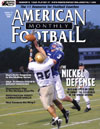AMERICAN FOOTBALL MONTHLY THE #1 RESOURCE FOR FOOTBALL COACHES
Article CategoriesAFM Magazine
|
The Strength Report: Skill Developmentby: Ron McKeeferyAsst. Athletic Director, Strength & Conditioning, University of South Florida © More from this issue These days a strength and conditioning coach has to be more than a weight lifting coach. They must be a mentor, counselor, nutritionist, etc. However, one area that must be well versed for a team to have great success on the field is skill development. Most seasons are between 3-4 months in length. This leaves 8-9 months of off-season time that position skills are often excluded. There must be a direct transfer from what is being done in those 8-9 months in the off-season to what will be done for the 3-4 months of the season. Letís face the fact that not every athlete loves the weight room. It is an uncomfortable feeling to push the body to the point where a neuromuscular adaptation occurs. What you do in the weight room needs to make sense to the athlete. Every exercise we do is explained to that athlete on how it will help th....The full article can only be seen by subscribers. Subscribe today!
|
|
|||||||
| HOME |
MAGAZINE |
SUBSCRIBE | ONLINE COLUMNISTS | COACHING VIDEOS |
Copyright 2025, AmericanFootballMonthly.com
All Rights Reserved





